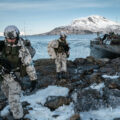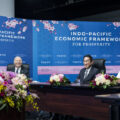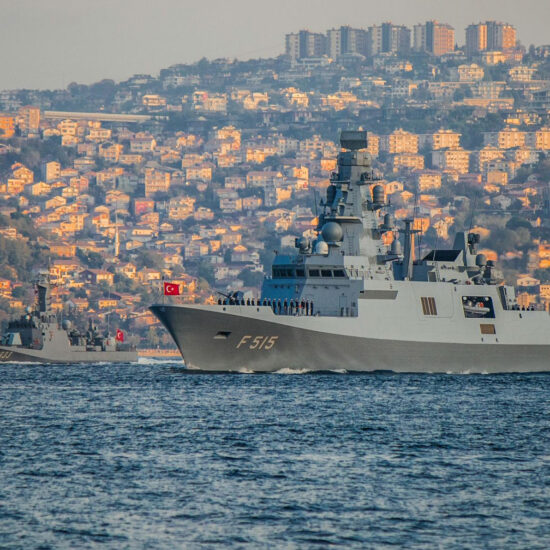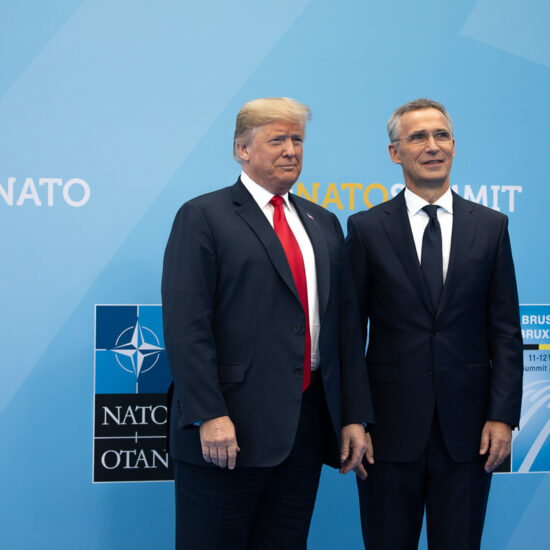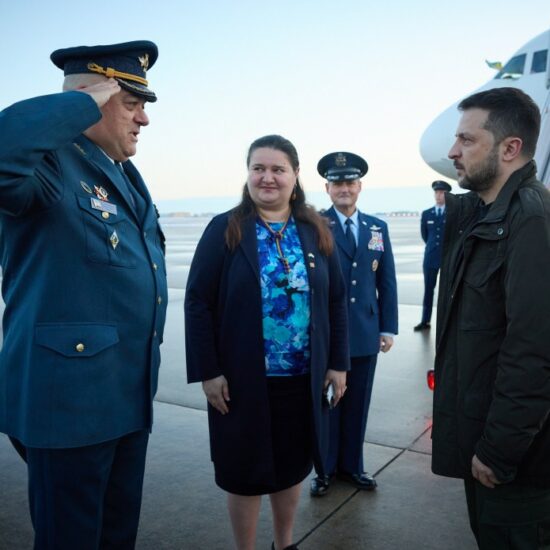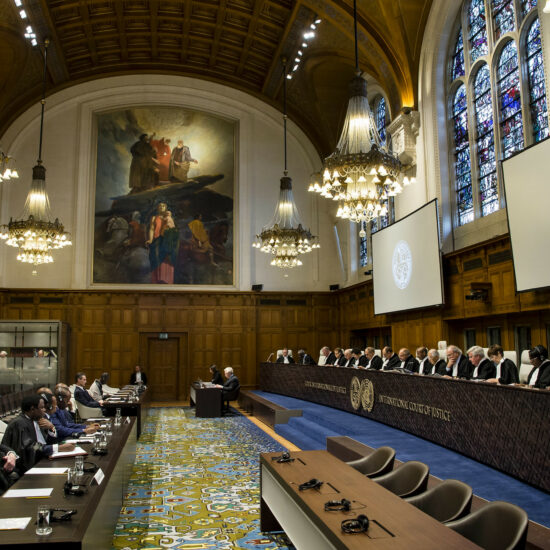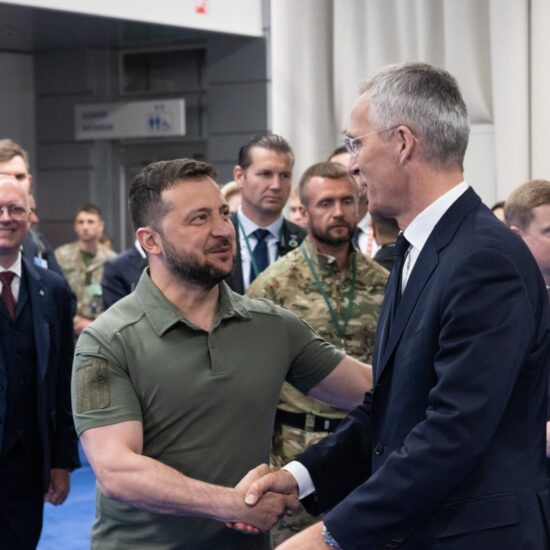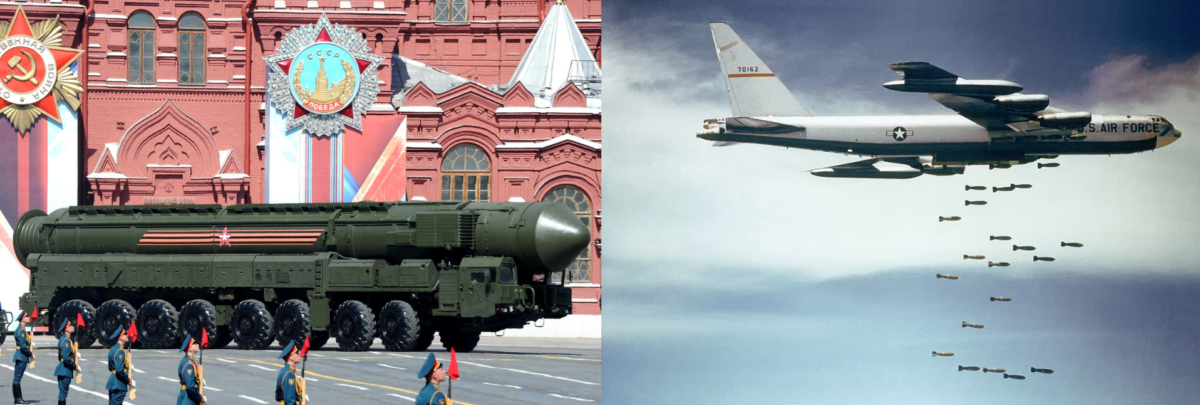
Image Credits: President of the Russian Federation, U.S. Air Force.
Arta Moeini | Research Director
Alexandra Slobodov | Research Associate
This policy briefing is part of a series of reports for the International System 2050 Program. Zero in on the Arctic dimension of nuclear arms control here.
ISSUE
Nuclear arms control is a critical aspect of managing great power competition in the international system. Developing a strong and clear understanding of arms control with other great powers is a crucial part of ensuring America’s military and economic security. An absence of denuclearization agreements poses a significant risk of escalatory spirals and an arms race which could cause further financial drain, worsening the COVID-induced global recession.
During the Cold War, progress was made on the denuclearization front. In fact, arms control agreements formed one cornerstone of US-Soviet diplomacy. Within the current multipolar system however, states have been increasingly hesitant to agree to controls on their missile defense programs, as they believe such treaties aim to ban dual-use (i.e., conventional and nuclear) missiles and launchers out of concern that they could be used in nuclear arsenals. The recent ambivalence toward arms control agreements among great powers stems chiefly from the belief that a state’s participation will undermine its self-defense ability using conventional weapons, particularly as major states seek to achieve relative defense parity with other great powers. Future approaches to nuclear arms reduction must, therefore, recognize major states’ desire for a national defense strategy centered around conventional forces and be attentive to the sovereignty rights and national interest of sovereign nations.
BACKGROUND
Nuclear arms reduction has been a central issue in the international system at least since 1969 when the United States and the Soviet Union first agreed to negotiate arms control agreements at the Strategic Arms Limitation Talks (SALT) in the midst of the Cold War. These initial meetings led to the 1972 Anti-Ballistic Missile Treaty (ABMT), which limited the U.S. and the U.S.S.R to two ABM defense complexes, each consisting of 100 ABMs. These ABM systems were the main line of defense against incoming ballistic missiles, yet they were restricted by the ABMT out of fear that they would jeopardize the strategic balance presumed by the mutual deterrence and mutual assured destruction doctrines. Following the September 11 Attacks, the U.S. withdrew from the ABM Treaty, as it was perceived that the agreement would constrain America’s ability to defend herself against “rogue states”.
SALT I and SALT II also led to the establishment of Strategic Arms Reduction Treaties (START), a series of agreements to reduce deployed strategic arsenals. Ratified in 1991 and expired in 2009, START I limited the U.S. and the Soviet Union to 1,600 deployed delivery vehicles holding a maximum of 6,000 nuclear warheads each. Replacing START I and SORT (a treaty that did not require destruction of weapons and was created following America’s withdrawal from the ABM agreement), New START was ratified in 2010 and is set to expire in 2021, with the option for a five year extension. Both the U.S. and Russia met the treaty’s requirement to complete the reductions to 1,550 deployed strategic nuclear warheads and 700 deployed strategic delivery systems each by February 5, 2018. The chart below demonstrates how nuclear weapon stockpiles have fluctuated since the beginning of the Cold War (with major nuclear arms control agreements indicated):
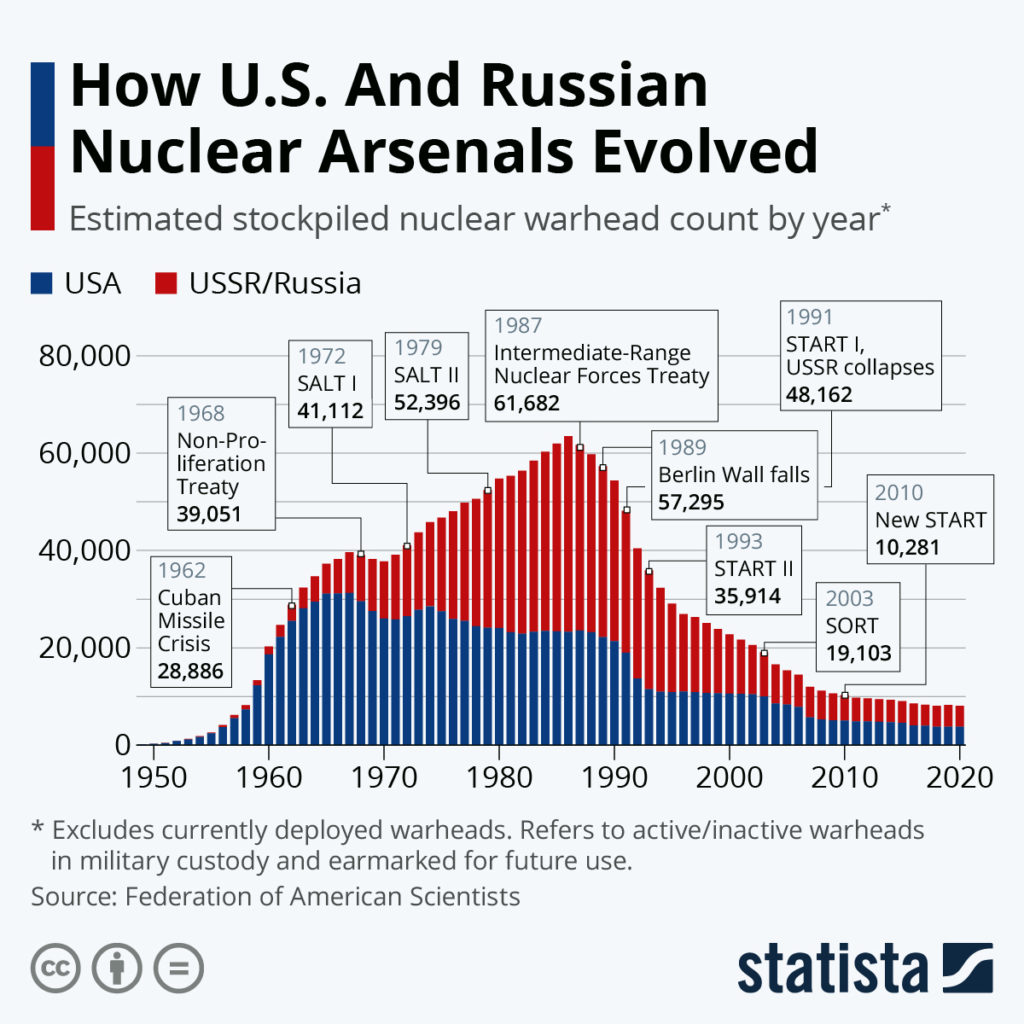
In recent years, the U.S. and Russia have actively worked to upgrade and modernize their nuclear technology, while China has worked to expand its own nuclear program. Nuclear-armed France and Britain have been unwilling to negotiate disarmament, citing fears of renewed Russian aggression in Europe. Despite decades of progress on arms control, the international system is now moving in the opposite direction–away from a commitment to arms control and toward a potential arms race. In a multipolar world, states are increasingly seeking to protect their national security, and thus have been wary of arms reduction agreements which impose limits on the conventional weapons they consider vital for national defense and for maintaining relative parity with their great power competitors.
Great Power Perspectives on Arms Control
The United States
In 2010, the U.S. announced plans to spend $1 trillion on developing new bombs and delivery systems, including smaller, more discriminate nuclear warheads. Since 2016, the U.S. has continued its modernization program (including more modernized strategic delivery systems, updated command and control networks, and refurbished nuclear warheads) with a promise to increase its spending to $1.7 trillion over the next 30 years. As part of its modernization efforts, Washington also earmarked at least $100 billion for its intercontinental ballistic missile program. As it continues its efforts to upgrade its nuclear weapon systems and abstains from ratifying the Comprehensive Nuclear-Test-Ban Treaty (CTBT), the U.S. seems to have adopted a gradual and incremental approach to disarmament.
In response to Russia’s ongoing noncompliance with the Intermediate Range Nuclear Forces (INF) Treaty, which obligated both America and Russia to eliminate all nuclear and conventional ground-launched and ballistic cruise missiles with a range of between 500 and 5,000 kilometres, the U.S. withdrew from the agreement in 2019. Moreover, the U.S. has also expressed concern about China and Iran building conventional intermediate range missiles. While America was banned from developing such weapons under the INF Treaty, Washington claims the terms of the INF treaty have left it at a relative disadvantage against adversaries that are not bound by comparable missile treaties.
The New START agreement, on the other hand, only imposed limits on nuclear weapons. Set to expire in February 2021, there have been minimal efforts on the part of the Trump Administration to extend the Treaty. President Trump is reported to have rejected a treaty extension offer made by Russian President Vladimir Putin during a call in February 2017. During the Helsinki talks in July 2018, the U.S. was again unable to reach an agreement with Russia about Washington’s conditions for treaty implementation. Disagreements extended to the status of both Russia’s tactical nuclear weapons and new strategic nuclear weapons (which do not fall under the terms of the New START Treaty), in addition to Russia’s noncompliance with the INF Treaty. In the 2018 talks, Washington once again stressed that in its view it was imperative to engage China in future discussions in order to limit Beijing’s growing arsenal. However, in August 2020, the U.S. suggested that in the absence of such amendments that it deemed necessary for extending the New START, Washington would be open to Russia joining a “politically binding agreement” toward a future treaty framework that would limit strategic and tactical nuclear warheads, as well as create a path toward an eventual multilateral treaty with China.
Russia
Russia’s 2010 military doctrine outlined that Moscow would only activate its nuclear capabilities in response to the use of weapons of mass destruction or to a conventional attack that would pose an existential threat to that country, emphasizing a clear intent on deterrence rather than escalation. This commitment was also reaffirmed in the Basic Principles of State Policy of the Russian Federation on Nuclear Deterrence published in June 2020. Nevertheless, while complying with the regulations of the New START Treaty, President Putin refused the Obama Administration’s 2013 proposal for further reductions on its strategic nuclear weapons.
Concurrently, Russia has been developing new strategic offensive arms capable of evading American ABM systems and modernizing its stockpile of shorter-range tactical nuclear weapons to have “greater accuracy, longer ranges, and lower yields to suit their potential warfighting role”–all permitted under New START. However, as noted earlier, Russia was found in violation of its obligations under the INF Treaty in a 2014 Compliance Report in which they were found to be producing and testing ground-launched intermediate-range cruise missiles. The U.S. reiterated these findings in subsequent years and ultimately withdrew in 2019 prior to the agreement’s expiration.
Despite violating the INF Treaty however, Russia has consistently reaffirmed its interest in extending New START, though also asserting that it is not prepared to do so “at all costs.” Russia’s Foreign Minister Sergei Lavrov agreed with the U.S. that they should enter into further arms control discussions with other nations possessing nuclear weapons. Yet, Lavrov has argued that if the U.S. wants China at the table, then America’s nuclear-armed allies, the UK and France–whose nuclear missiles are able to reach Russian targets–should also take part in multilateral arms control discussions. In response to suggestions that Russia should encourage China to participate in nuclear arms reduction, Lavrov emphasized the principle of sovereignty of independent states, noting that participation “must be based on the free will of the potential participants” such that “no country may be coerced into them.”
Additionally, if a successor to New START were to be negotiated that would include Russia’s newly-developed weapons, Moscow holds that it would also be necessary to place limits on America’s ABM systems and conventional long-range delivery systems, such as its Conventional Prompt Global Strike (CPGS) weapons.
China
Throughout the past decade, China has been modernizing and expanding its own nuclear capabilities. However, its nuclear arsenal of approximately 300 warheads still remains significantly smaller than those of the U.S. and Russia. China has “co-mingled” its nuclear and conventional weapons by mounting both types of warheads on the same missiles and deploying both conventional and nuclear launch brigades to the same bases. While this is considered to be a method to preempt either form of attack, it also increases the risk of a dangerous escalatory spiral in the case that any conflict did break out. For example, if America launched an attack on China’s conventional forces, but accidentally hit their nuclear systems, ambiguous wartime information could lead China to believe that the U.S. was intent on destroying its nuclear capabilities and respond in kind. Needless to say, even a “limited” nuclear conflict between global powers could have devastating consequences.
China has emphasized that it maintains a defensive nuclear posture, employing a policy of “assured retaliation,” and upholding a “no first use” pledge–unlike the U.S. and Russia. Moreover, following its withdrawal from the ABM Treaty, Washington eventually deployed ballistic missile defense systems, presumably to counter “rogue states” such as North Korea. This was met with criticism by Beijing, which felt that the deployment threatened China’s national security, making it more vulnerable to attacks that could disable its nuclear capabilities. The presence of America’s missile defense systems in South Korea and future stationing of nuclear weapons in East Asia prove to be one of China’s key concerns regarding arms control.
China believes that the U.S. and Russia should be the first movers toward denuclearization since both have significantly larger arsenals than any other country–together holding 90 percent of the world’s nuclear weapons. When asked by the U.S. to join negotiations on arms control, China has maintained that such talks would be unrealistic given the discrepancy in arsenal size. China would not agree to a trilateral treaty with imbalanced restrictions, claiming that such a treaty would allow the U.S. and Russia to keep a high number of nuclear weapons but limits China to a small fraction relative to theirs.
The Chinese government has also pointed out that an equal trilateral treaty would be impossible, as neither the U.S. nor Russia would be willing to allow China to expand its arsenal to their size or reduce theirs down to China’s level. Beijing has similarly rejected calls to exercise more transparency about its nuclear program’s size and structure, as it believes providing such information would benefit those planning attacks on its forces. Despite these security challenges, at least one Chinese expert believes that it would be in China’s national interest to enter disarmament talks as an arms race would put additional strain on its already slowing economy. Joining future arms control talks could also generate soft power for Beijing and “raise China’s status as a major global military power on a par with the two former superpowers.”
Importance of Arms Control
Risk of Conflict
New START includes provisions which allow the U.S. to monitor and verify Russia’s compliance with the Treaty. In the absence of bilateral arms control treaties that would guarantee and institutionalize verification procedures, the exchange of information on the countries’ respective weapons systems would be severely and dangerously curtailed. In 2019, the commander of the U.S. Strategic Command, Air Force Gen. John E. Hyten, stated that the treaty is “unbelievably important” in understanding the scope and strategy of Russia’s nuclear forces. Without arms reduction agreements to provide a monitoring mechanism, there is an increasing risk of “a vicious circle of clashing geopolitical ambitions, distorted perceptions of each other’s intent, new and poorly understood technologies, and disappearing rules of the game” which could turn disastrous.
Another area of particular concern is tactical nuclear weapons. As part of the 1991 Presidential Nuclear Initiatives (PNIs), President George H. W. Bush unilaterally banned all tactical nuclear weapons. Also referred to as non-strategic weapons, tactical nuclear weapons have a short-range and low-yield capability, which proponents believe renders them particularly advantageous operationally and on the battlefield.
During the Cold War, the USSR and the U.S. deployed such tactical nuclear missiles along the West German-East German border in order to serve as a deterrent for the European theater. After the fall of the Berlin Wall, the collapse of the Soviet Union and the end of the Cold War, President Bush recognized that tactical nuclear weapons were no longer necessary as conventional weapons were comparable substitutes for military dominance while minimizing the risk of escalation into all-out nuclear war.
A study about the PNIs by the Centre for the Study of Weapons of Mass Destruction reported that owing to the strategic shifts brought about by the end of the Cold War, President Bush, his National Security Advisor Brent Scowcroft, and the then Chairman of the Joint Chiefs of Staff Colin Powell concluded at the time that utilizing ground and sea-launched non-strategic nuclear weapons was no longer in America’s national interest:
These views of Chairman Powell and Navy leaders on tactical nuclear weapons were strengthened substantially by the seismic strategic changes of 1989–1991. First were the end of the Cold War and the progressive diminution of the Soviet threat. Second was the emergence of new zones and forms of conflict—highlighted by Operation Desert Storm in 1991 against Iraq—in which U.S. conventional military force would have primary, and growing, importance. Further, advances in conventional weaponry led the U.S. military to conclude that conventional forces could now accomplish many missions that earlier required nuclear weapons. As a result of those changes, many military leaders came to view both ground- and sea-launched tactical nuclear weapons as impediments to conventional superiority and military dominance, rather than as assets.1
As the international system shifted from bipolarity to unipolarity in the aftermath of the Cold War, the Bush administration made the strategic decision to alter America’s nuclear policy to better reflect the new geopolitical environment. In the years that followed, successive U.S. administrations deviated from that path to reincorporate tactical nuclear arms back onto America’s national defense strategy. As the unipolar moment of American supremacy gives way to a new multipolar order however, the U.S. finds itself at a similar junction once more–where it must rethink and reevaluate its nuclear strategy and adopt new policies that better fit the emerging multipolar international system and its new geostrategic realities.
Costly Arms Race
Already under pressure from COVID-19 and its economic impact, a nuclear arms race would put further strain on the U.S. economy. In 1996, it was estimated that the U.S. had spent $5.5 trillion on its nuclear program throughout the Cold War. Under the provisions of New START, the U.S. currently plans to invest approximately $1.7 trillion into nuclear weapons systems over the next 30 years. However, an arms race with two competitors, rather than one, would significantly increase nuclear arms spending. This would also divert funds away from pressing issues such as mitigating the pandemic and investing toward modern healthcare, education, and infrastructure. Some argue that there is already a “qualitative” arms race underway in the form of nuclear weapons modernization, but doing away with limitations on total weapons count could result in a “quantitative” arms race that no world power wants nor can afford in the long-run.
CHALLENGES
In February 2019, the U.S. withdrew from the INF Treaty. Though the treaty was due to expire later that year, America’s action was a direct response to Russia’s noncompliance with the treaty, as well as instigated over concerns about China’s unrestricted and expanding nuclear arsenal. In the current multipolar world, it is extremely unlikely that a new INF treaty could be successfully negotiated given that its very framework bans the conventional weapons that many states consider integral to their national defense.
New START, the only remaining bilateral U.S. – Russia arms control agreement, is set to expire in early 2021. This treaty limits both sides to 700 deployed strategic delivery systems and heavy bombers, puts a hard cap of 1,550 on deployed strategic nuclear warheads, and employs an inspection regime to verify that each side honors its commitments. Although it is possible to extend the treaty until 2026, it is becoming increasingly unlikely that the U.S. and Russia will do so.
The Russian government has consistently stated that it is prepared to extend the agreement— its possession of nuclear weapons has allowed it to keep its status as a “great power,” while equal arms limitations with the U.S. allows Russia to avoid the economic strain caused by an arms race. Nevertheless, the current U.S. administration has maintained that any extension of the treaty depends on Moscow meeting Washington’s conditions— those include China joining the disarmament talks and incorporation of Russia’s new weapon systems under the existing framework of the New START agreement. However, in response to Russian disapproval of these conditions, the U.S. suggested that another option is to find an agreement binding Russia to a future treaty which would limit its strategic and tactical nuclear warheads, as well as create a path for China to enter nuclear reduction discussions.
Thus far, China has shown no interest in arms control treaties, possessing a significantly smaller arsenal in contrast to the U.S. and Russia which together hold 12,175 nuclear warheads. As explained by one Chinese diplomat, neither the U.S., nor Russia, would accept China increasing its nuclear arsenal up to their levels or decrease their own arsenals to be on par with China’s. The Chinese government has also rejected any form of asymmetrical treaty that would set unevenly low limits on China’s arsenal relative to what the U.S. and Russia would be permitted to keep.
It will prove extremely challenging, if not impossible, to negotiate a trilateral deal with Russia and China that would satisfy all parties prior to the New START’s expiration in early 2021. Given that the extension deadline is less than four months away, the U.S. must act quickly if it is to maintain its last remaining bilateral arms control agreement with Russia. Meanwhile, it is critical to address the underlying issues that both caused Russia to violate the INF Treaty and which prevent China from joining possible arms control talks.
Both Russia and China strive to protect their national security by developing conventional missiles that can hold either a nuclear or a conventional warhead–but this capability does not necessarily mean that states with dual-use weapons prefer to engage in nuclear war. To be sustainable, any future treaty must outline policies that reaffirm the right of each sovereign state to conventional weapons as part of their national defense strategy.
POLICY RECOMMENDATIONS
Extend New START
- Extending New START would not impede America’s nuclear modernization plans as all such prospective developments were designed to be fully permitted within the scope of the Treaty. Additionally, as the provision to extend the Treaty is included within the text of the agreement, the U.S. Administration would also not have to obtain Senate approval.
- While Russia is not willing to renegotiate New START to cover its new technologies, Russian Foreign Minister Lavrov has argued that Russia is open to discussing these issues at future summits that are specifically focused on maintaining strategic stability. Additionally, as new weapons technologies are unlikely to become active in the near future, it allows for both countries to discuss their concerns long before such weapons are deployed.
- While the INF Treaty limited both conventional and nuclear weapons, New START only imposes restrictions on the latter. The U.S. can therefore continue to remain competitive in the area of conventional weapons, while achieving its objective of nuclear arms reduction. As such, New START’s framework does not preclude Washington from competing with Beijing on conventional arms, including “Chinese missile, submarine, and hypersonic developments.”
- Extending New START would further allow the U.S. to retain the treaty’s benefits, such as preserving the reductions made in deployed strategic warheads and verifying the size and structure of Russia’s nuclear forces, while also giving it time to negotiate a nuanced START 3.0 that would realize its objectives of engaging China and mitigating Russia’s technological developments. The graph below demonstrates the progress made by both the U.S. and Russia in reducing deployed strategic nuclear warheads since the ratification of New START:
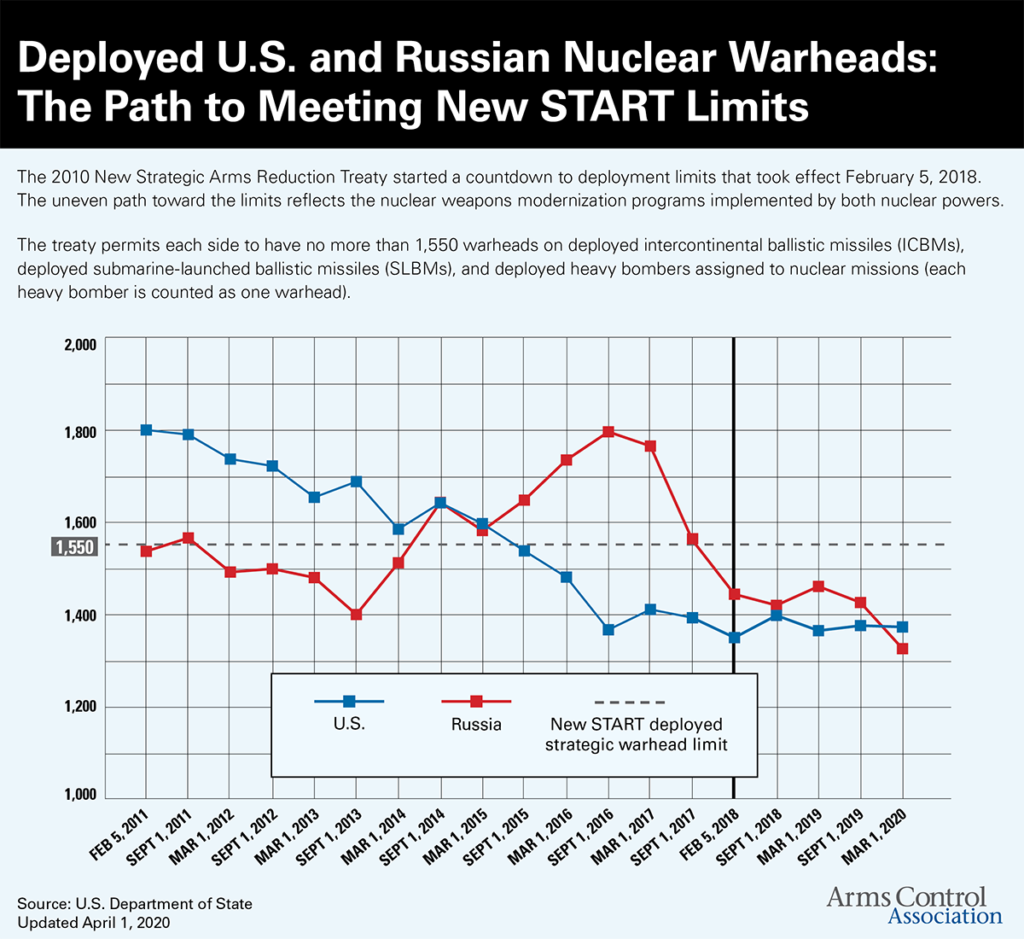
Move toward a bilateral START 3.0
- Keeping the Treaty’s Bilateral Structure and Using It As a Framework for Comprehensive Nuclear Arms Reduction
Rather than developing a trilateral treaty with the U.S., Russia, and China–most states have no desire to join further multilateral treaties or international organizations–the U.S. must ensure that START 3.0 remains bilateral and serves as a comprehensive framework to be used in future nuclear arms control treaties. The Treaty’s framework could be used as a blueprint for diplomats and policymakers in negotiating future binding bilateral agreements between the U.S. and China. Engaging in bilateral disarmament negotiations permits countries to set up agreements based on each party’s specific nuclear capacity and strategic nuclear development plans.
- Reaffirming the Right to Conventional Weapons
A major shortcoming of the INF treaty was the limits it placed on conventional arms. States employ conventional weapon systems to advance and support their non-nuclear national defense priorities and capabilities. Allowing states to maintain and develop conventional weapons, while placing strong limits on nuclear and other WMD capacities, affirms their sovereignty and prevents treaty failures that would otherwise occur when states utilize dual-use conventional and nuclear weapon missiles and launchers–precisely, what caused Russia to violate the INF Treaty and partially what prevents China from participating in arms control talks.
- Banning Tactical Nuclear Weapons
The use of low-yield and short-range tactical nuclear weapons in the battlefield within the “limited war” scenarios creates a fast trajectory to escalation. The U.S. has banned tactical nuclear weapons once before– the 1991 PNIs outlined the George H. W. Bush administration’s unilateral commitment to severely limit America’s tactical nuclear stockpiles. Using this earlier precedent, the current U.S. administration could take a leading role in this area by introducing an outright ban on tactical nuclear weapons. The U.S. could then ask Russia to demonstrate its bona fides by adopting a similar stance. Such a wholesale break with non-strategic nuclear weapons among major world powers could provide an important safeguard against the possibility of an all-out nuclear war.
Additionally, if the U.S. and Russia agreed to eliminate all tactical nuclear weapons, China could consider this a credible move toward denuclearization, and thus be more open to participating in bilateral U.S. – China dialogue on nuclear arms reduction.
- Setting a Hard Cap on Strategic Nuclear Weapons
In keeping with past START agreements, the new treaty should continue to place strict limits on strategic nuclear weapons, permitting only a specified quantity for deterrence purposes. The actual limits outlined by the bilateral treaty would depend on the concrete size and capabilities of each state’s nuclear arsenal, as opposed to abstract and general limits set out by a multilateral arms treaty or organization.
- Establishing a Demilitarized Arctic Zone
The Cold War period was marked by the belief that America’s security was directly linked to maintaining the Arctic as a frontier of deterrence against the Soviet Union–a renewed possibility in the absence of any bilateral arms control. START 3.0 is an opportunity to establish a demilitarized Free Arctic Zone (FAZ) to ensure that the area remains open for international shipping and commercial traffic–an increasingly important economic incentive given the melting of Arctic ice and emergence of new trade routes in the region.
This demilitarized zone could be modeled on the 1967 Outer Space Treaty which prohibited the use of nuclear weapons in space and declared it open to all for peaceful purposes and scientific exploration. Additionally, for a middle power such as Canada which possesses a vast Arctic territory, a heightened military presence could exacerbate issues surrounding Canada’s sovereignty in the North, especially given recent assessments of the region’s increased geopolitical importance.
- Adopting No-First-Use Pledge (NFU) as a Fundamental Principle
A NFU policy requires that a state would only engage its nuclear weapons in response to a nuclear strike against itself or its allies, as opposed to initiating such a strike. China has already adopted the pledge. The Soviet Union committed to a NFU policy in 1982 but ultimately Russia withdrew the pledge in 1993. The U.S. has never committed to the policy, as it considers the right to first use against other nuclear states to be a method of deterrence. However, adopting this pledge would demonstrate America’s genuine commitment to nuclear arms reduction–important in leveraging the benefits of nuclear limitation treaties with China. Moreover, should the U.S. Administration decide to adopt the NFU pledge there would likely be bipartisan support for the measure in U.S. Congress.
CONCLUSION
With the impending expiration of New START, the last remaining bilateral United States-Russia arms control deal, it is imperative to reassess previous treaties in order to understand their shortcomings and develop a clear strategy for negotiating more effective agreements in the future.
Past treaties (such as the INF) have placed exacting limits on conventional missiles while ignoring short-range, low-yield tactical nuclear weapons–despite the risk of escalations were these tactical weapons to be deployed in the battlefield. A successful START 3.0 would continue to place strict limits on strategic nuclear weapons but also ban all tactical nuclear weapons while reaffirming state sovereignty by permitting conventional weapons. Ideally, it would also include the provision of a Free Arctic Zone and adhere to a no-first-use policy. Such a treaty would serve as a comprehensive framework for future bilateral agreements on nuclear arms reduction.
Before the U.S. could negotiate a successor to New START however, it must first extend the existing treaty as it stands. Such an extension would give Washington the time and flexibility it requires to negotiate the exact terms for a START 3.0. In doing so, Washington could avoid a multi-front nuclear arms race that would not only significantly impair its economy, which is already heavily overextended due to the impact of the Coronavirus pandemic, but is unsustainable and dangerous in the long-run.
1Susan J. Koch, “The Presidential Nuclear Initiatives of 1991-1992,” in Center for the Study of Weapons of Mass Destruction Case Study Series, ed. Paul I. Bernstein (Washington, D.C: National Defense University Press, 2012), 6.
Arta Moeini is research director at the Institute for Peace and Diplomacy and a postdoc fellow at the Center for the Study of Statesmanship. Dr. Moeini’s latest project advances a theory of cultural realism as a cornerstone to a new understanding of foreign policy.
Alexandra Slobodov is a Research Associate working on the International System 2050 program. Before joining IPD, Alexandra worked as a Research Assistant for the Department of Political Science at the University of British Columbia. Alexandra holds a Bachelor’s in International Relations from the University of British Columbia and wrote her thesis on Canadian–Russian relations in the Arctic following the 2014 Crimean Crisis.
